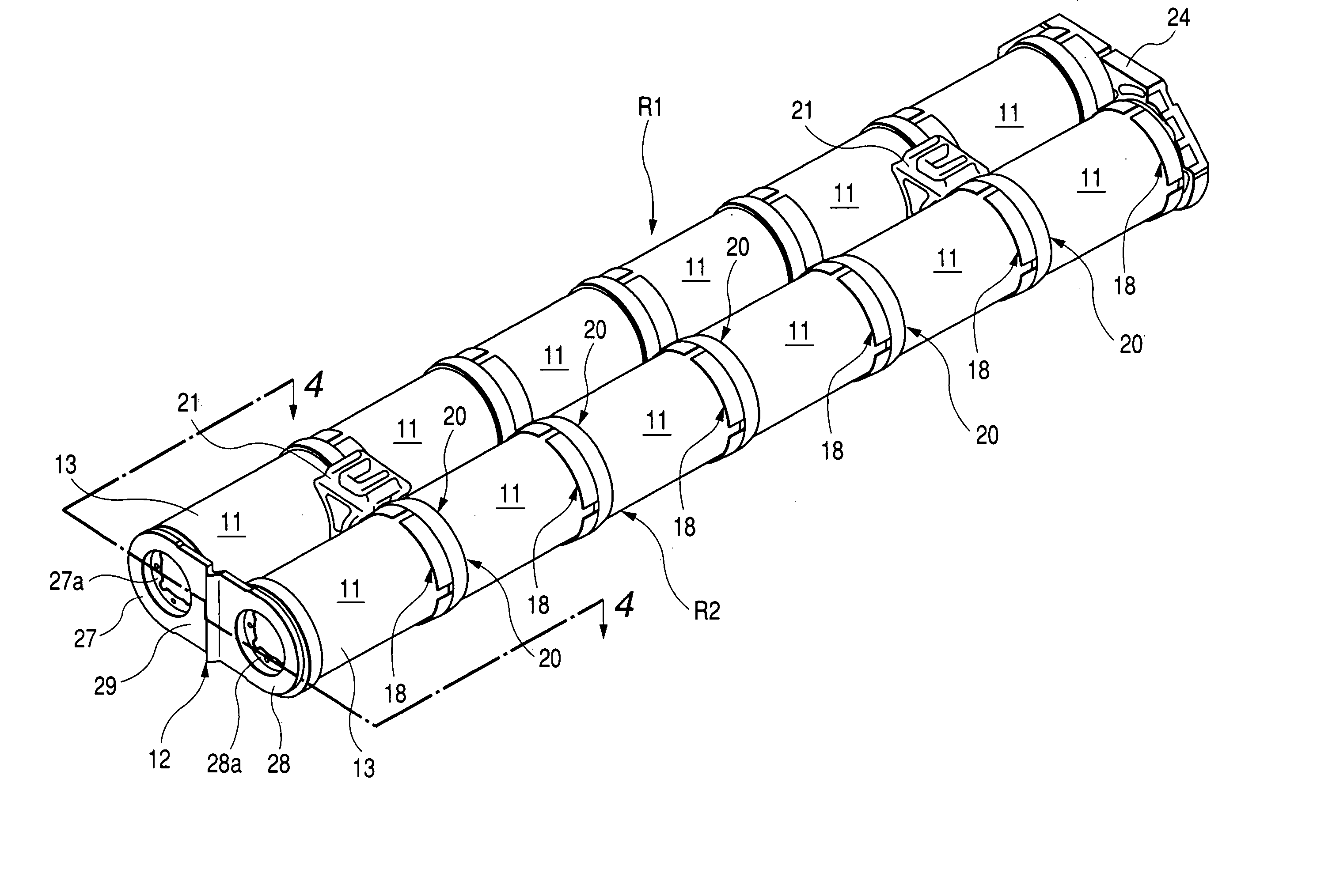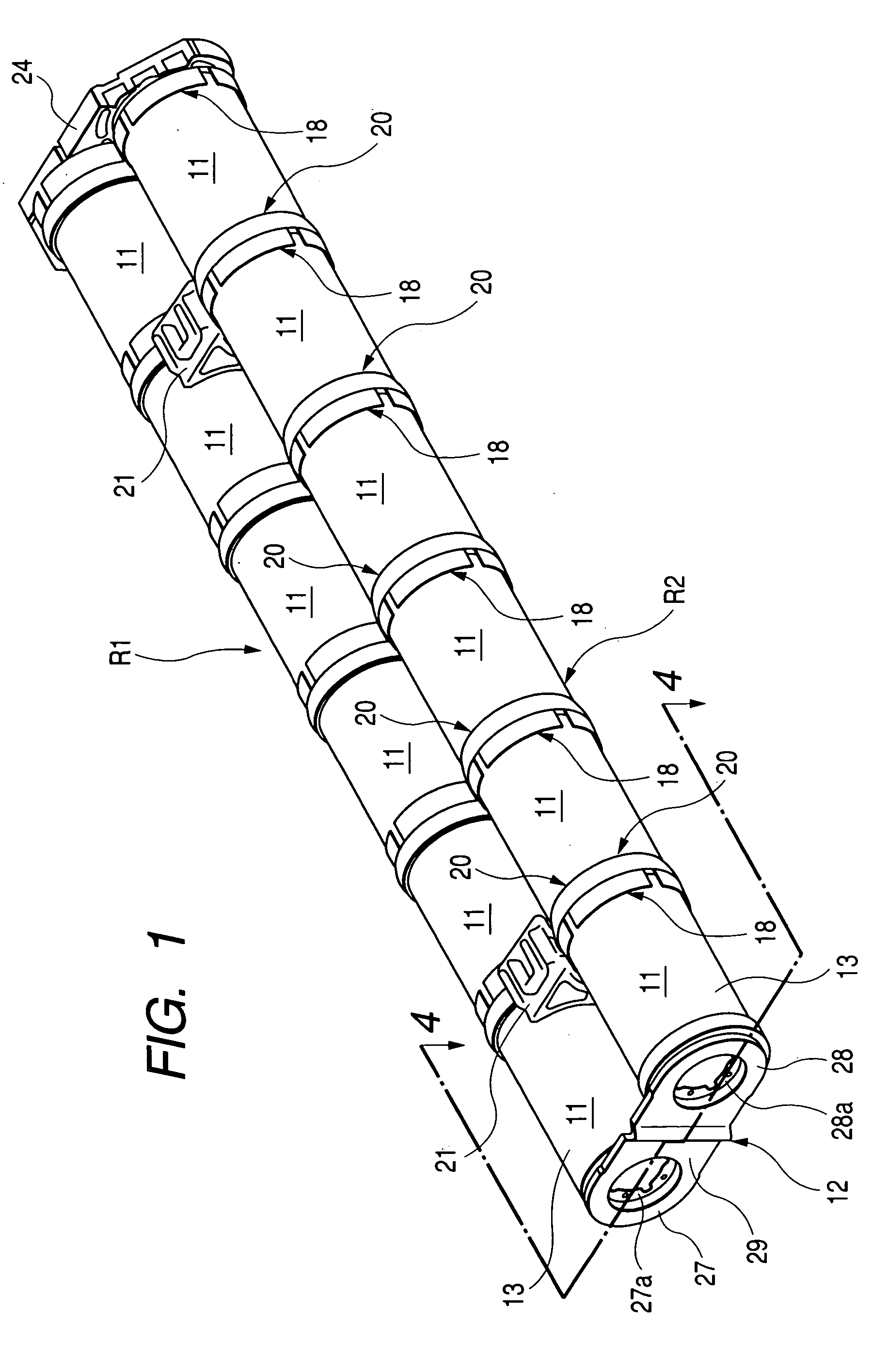Connecting structure for electric cells
a technology of connecting structure and electric cell, which is applied in the direction of cell components, cell component details, coupling device connections, etc., can solve the problems of increasing shortening the life of electric cells, and affecting the efficiency of electric cells, so as to avoid damage to electric cells, reduce the number of areas, and reduce the effect of electric resistance of the connecting ring
- Summary
- Abstract
- Description
- Claims
- Application Information
AI Technical Summary
Benefits of technology
Problems solved by technology
Method used
Image
Examples
first embodiment
[0042] FIGS. 1 to 6 illustrate the present invention. FIG. 1 is a perspective view of an electric cell module. FIG. 2 is an exploded perspective view of the electric cell module. FIG. 3 is an exploded perspective view of the electric cell module when viewed in the direction opposite to that in which the electric cell module is viewed in FIG. 2. FIG. 4 is a cross-sectional view showing a part of the electric cell module along line 4-4 shown in FIG. 1. FIG. 5 is a front view of a connecting bus bar when viewed from the direction of arrow 5 in FIG. 4. FIG. 6 is a cross-sectional view taken along line 6-6 in FIG. 5.
[0043] First, in FIGS. 1 to 3, this electric cell module is configured while first and second electric cell rows R1, R2, which are connected in parallel to each other, are connected in series by way of a connecting bus bar 12, wherein each of the cell rows R1, R2 is formed by connecting a plurality of electric cells 11; e.g., six electric cells 11, 11, . . . , in series to ea...
third embodiment
[0077]FIGS. 12 and 13 illustrate the present invention. FIG. 12 is a front view of a connecting ring 25 corresponding to FIG. 10. FIG. 13 is a cross-sectional view taken along line 7-7 of FIG. 12.
[0078] The connecting ring 25 integrally includes a large-diameter short cylindrical section 25a, a first flange section 25b, a small-diameter short cylindrical section 25c, and a second flange section 25d. The large-diameter short cylinder section 25a is shaped into a cylinder having one open end, and is fitted over and welded to a surface of an outer periphery of the bottomed cylinder 13 (see the first embodiment). The first flange section 25b extends radially inward from the other end of the large-diameter short cylindrical section 25a and comes into close contact with an outer surface of a closed end of the bottomed cylinder 13. The small-diameter short cylindrical section 25c having one open end is connected to an inner periphery of the first flange section 25b, extends in the directio...
second embodiment
[0080] The connecting ring 25 exclusive of the weld sections 25a . . . of the large-diameter short cylindrical section 25a and the weld sections 25da . . . of the second flange section 25d is set to be equal in wall thickness or greater in wall thickness than the thicker one of the weld sections 25aa . . . and the weld sections 25da . . . . More specifically, in the second embodiment, the wall thickness B2′ of the weld sections 25da . . . of the second flange section 25d is equal to the wall thickness B1′ of the weld sections 25aa . . . of the large-diameter short cylindrical section 25a. Therefore, the wall thickness of the connecting ring 25 exclusive of the weld sections 25aa . . . and 25da . . . is set to be equal to or greater than the thickness B1′ of the weld sections 25aa . . . and the wall thickness B2′ of the weld sections 25da . . . .
[0081] Accordingly, a wall thickness C′ of the first flange section 25b and the small-diameter short cylindrical section 25c of the connecti...
PUM
| Property | Measurement | Unit |
|---|---|---|
| thickness | aaaaa | aaaaa |
| thickness | aaaaa | aaaaa |
| thickness | aaaaa | aaaaa |
Abstract
Description
Claims
Application Information
 Login to View More
Login to View More - R&D
- Intellectual Property
- Life Sciences
- Materials
- Tech Scout
- Unparalleled Data Quality
- Higher Quality Content
- 60% Fewer Hallucinations
Browse by: Latest US Patents, China's latest patents, Technical Efficacy Thesaurus, Application Domain, Technology Topic, Popular Technical Reports.
© 2025 PatSnap. All rights reserved.Legal|Privacy policy|Modern Slavery Act Transparency Statement|Sitemap|About US| Contact US: help@patsnap.com



